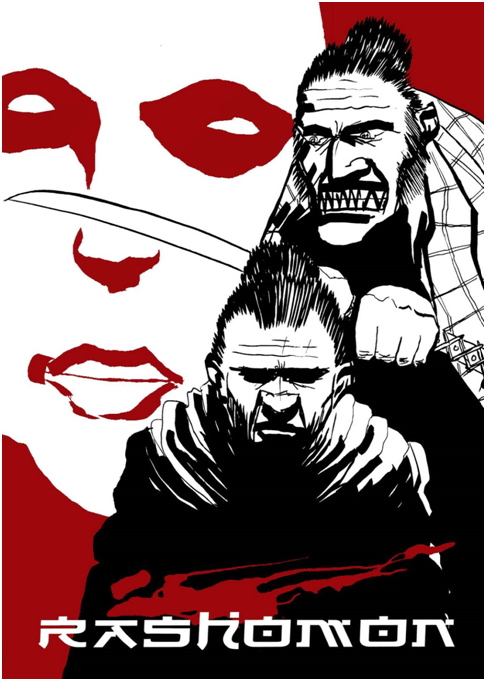
A live-action prototype in which audience members have some agency in determining the manner and the order in which they experience the three main characters’ stories in Rashomon through the use of a 360º stage setup and rotation-sensor technology.
In traditional renditions of Rashomon one hears the testimonies and views the stories of the three main characters (Bandit, Wife, and Husband) in a predetermined sequential order. One question we asked ourselves when developing this prototype was if the order in which the stories are told in any way influences an audience member’s perception of which character is telling the truth. With this question in mind, we developed our idea for the prototype around the notion of perspective and giving audience members some agency in determining the manner and the order in which they experience the three characters’ differing perspectives during a live performance of their stories.
We can achieve this level of agency through the use of a 360 degree stage setup with dynamic sound capabilities. The stage will surround a group of audience members (5-10 people for the prototype), all seated in swivel chairs rigged up with rotation sensors, that will allow them to willfully direct their attention around the stage and interactively alter their experience with the performance. Thanks to the rotation sensors we will be able to measure where each audience member is facing in his/her chair, and thus determine which character or section of the stage is receiving his/her attention. We can take this data and use it to affect things like the amplification of the sounds coming from the speakers set up around the stage which will be playing prerecorded dialogue from each of the three characters as well as ambient sounds that represent each character. Depending on the amount of attention the collective audience is giving a certain character we will be able to determine whether or not that character’s version of the story will be acted out first, second, or third. The audience interacting in this manner supplements the content of the play and should make for an overall richer theatrical experience for everyone involved with the performance.
Design Document
Video from Performance
Plot
In 12th century Japan, a samurai and his wife are attacked by the notorious bandit Tajomaru, and the samurai ends up dead. The three parties involved, the bandit, the wife, and the samurai (who tells his story from the afterlife through a medium) each tell their version of the story as to how the samurai ended up dead. Each of their stories is remarkably different, all saying they perpetrated the killing of the samurai. The true facts are never revealed. Who is telling the truth?
Characters
Tajomaru (The Bandit)
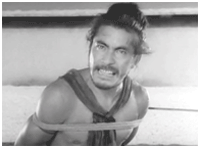 The infamous bandit, Tajomaru, is crude, crass and cocky. He behaves more like an animal than a human being,
but is intelligent in his ability to scheme and think outside of man’s laws and established societal structures.
The infamous bandit, Tajomaru, is crude, crass and cocky. He behaves more like an animal than a human being,
but is intelligent in his ability to scheme and think outside of man’s laws and established societal structures.
Kinume (The Wife)
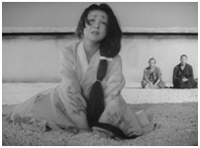 Kinume is mysterious. In her story she claims to love her husband so much that she had to kill him when he
looked upon her with disdainful eyes. At the same time she shamed herself by returning the embrace of Tajomaru’s
lips.
Kinume is mysterious. In her story she claims to love her husband so much that she had to kill him when he
looked upon her with disdainful eyes. At the same time she shamed herself by returning the embrace of Tajomaru’s
lips.
Takehiko (The Dead Samurai and Husband)
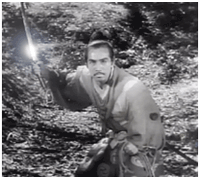 Takehiko, calling out from beyond the grave, is angry that his life was taken from him,
even though he claims to have killed himself.
Takehiko, calling out from beyond the grave, is angry that his life was taken from him,
even though he claims to have killed himself.
Setting
The Story of Rashomon takes place in Kyoto Japan, a little over a thousand years ago. More specifically, the action in the full story takes place at the edge of the Rashomon Gate, at a police court, and in a nearby forest. Our prototype will focus mainly on two out of the three settings: the police court and the forest. The tone of the story is a darker one and we should be aware of that when developing the sounds and the projections backdrops for this prototype.
Details
When:
Monday, May 4th: 7:00, 7:40, 8:20, 9:00
Tuesday, May 5th: 7:00, 7:40, 8:20, 9:00
Where:
Rauh Studio Theatre, Purnell Center, Carnegie Mellon University
Stage
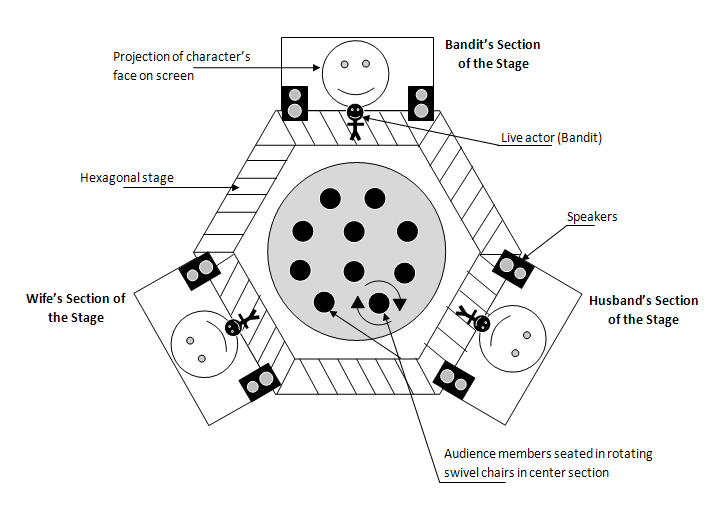
An octagonal stage will be set up around 5-10 audience members seated in swivel chairs. At any time during the performance, audience members can rotate their seats to face any section of the stage. Each seat will be equipped with a rotation sensor, which can detect what direction the audience member is facing. Three projection screens will be set up at opposite ends of the stage, and live actors portraying the Bandit, the Wife, and the Husband will be positioned in front of the screens at the beginning of the performance. Close-ups of the characters’ faces will be projected on the screens behind them. The projections of each character will show them in the police court testifying before the magistrate/jury (crowd) in what represents the present time. The live actors will act out events that have already taken place, the past, based off of each character’s story about what happened in the forest. Each character essentially has his/her own section of the stage, but there will be times when the actors should utilize all of the stage space.
Play Through
In the Beginning
The play begins with the three actors playing the Bandit, the Wife, and the Husband all positioned in front of their separate projection screens on their designated sides of the stage. The actors should be facing out towards the audience who are all seated in swivel chairs and may face any direction they like. Instead of the actors speaking at this point prerecorded dialogue of each character telling the setup story will play from their respective speakers. Prerecorded video of the characters’ faces will be projected behind each character and will sync up with the dialogue as the story is told by all three. The separate dialogue tracks will play over each other, but audience members can determine which they hear more prominently by collectively facing a certain character.
The Selection Process
While audience members get familiar with the characters and the setup story, a computer system tied in with the rotation sensors will be keeping track of how much attention they are giving certain characters. When the setup story finishes the system will determine which character received the most attention from the collective audience and the overhead lights will focus on that character’s section of the stage. The lights on the other characters will go out and their projections will temporarily fade out. At this time, the other two actors whose characters were not selected should make their way over to the selected character’s lit portion of the stage. All three should now take their positions in front of the selected character’s now dark screen and begin acting out the selected character’s version of what happened. Prerecorded videos of the non-selected characters’ facial reactions to the action on stage should also appear on their respective projectors at this time.
Performace and Preferences
Once the three actors on stage begin to act out one character’s story, the audience members will have three main focal points to which they can direct their attention: the live action, which should take place mainly at the selected character’s section of the stage, but can move around the whole stage at certain times, or the projections of either one of the other characters’ prerecorded reactions to the scene being played out. The speakers around the stage will play music that is representative of each character, and this music will be amplified depending on which direction(s) audience members are facing; this music will serve as feedback for audience members, who are actually determining which of the remaining two characters’ stories will play out next by observing their reactions.
The Ending
Each character will give a ’closing statement’ which will be a combination of dialogue from both live action and projections. The closing statements will play back in same order as the characters’ stories.
Chair


Swivel Chair
We are using a modified RUTGER / JULES chair from IKEA as the swivel chair. The modification comes in the form of a custom made casing that attaches to the bottom of the chair to house the sensor we are using to detect the direction the chair is facing.
Rotation Sensor
The sensor which is being used to determine the direction of the swivel chair is the Oak MagR Magnetic Rotational Encoder created by Toradex. It connects to a PC via USB. The sensor works by housing a magnet inside the sensor that dictates the angle of rotation. By rotating an external magnet over the sensor the internal sensor rotates. By connecting the magnet to the swivel chair and housing the magnet underneath the chair we are able to determine at what angle the chair is currently facing at all times.
Downloads:
C++ Code for Receiving / Calibration Sensor Data - Requires .NET Framework 3.0
Sensor Housing Documentation
Audio
Software (requires Windows XP or later)
Max MSP Patch - Requires Quicktime, Max
C++ Virtual MIDI Controller - Requires .NET Framework 3.0, MIDI YOKE
MIDI YOKE
PC - Audio Interface
Presonus Firebox 6x10 24-bit / 96k Firewire Recording System
Speakers
Gemini GX-801 250W 8" Powered PA speakers
Visual
Software (requires Windows XP or later)
Max Jitter - Requires Quicktime, Max
Projectors
Sharp XR-32X DLP Multi-Media Projectors
Screens
DA-LITE Complete Fast-Fold Portable Front and Rear Projection Screen - 63" x 84" - 105" Diagonal